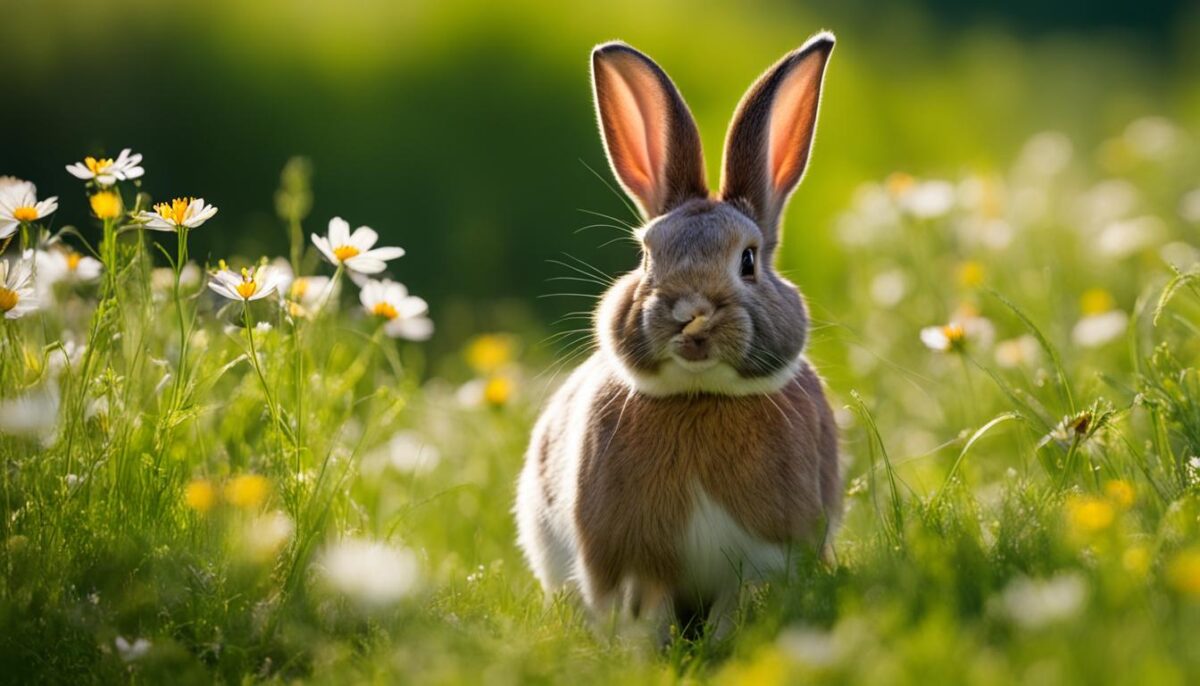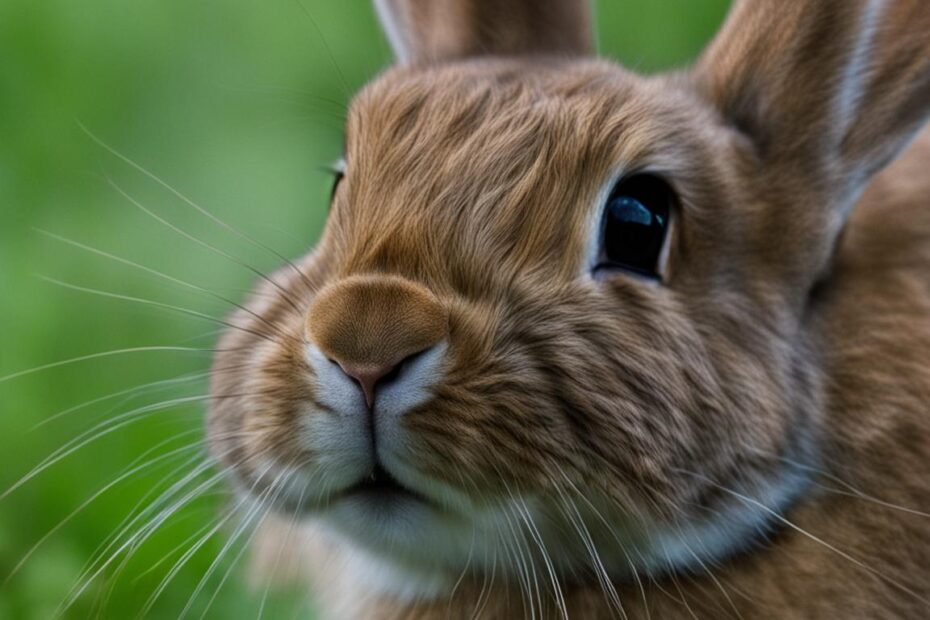Rabbits may seem like quiet pets, but they actually have a wide range of noises and sounds to communicate different messages. Understanding these rabbit noises is key to building a better bond with your pet.
Key Takeaways:
- Rabbits have specific noises for various occasions.
- Happy rabbit noises include clucking, buzzing, honking, and purring.
- Warning sounds indicate unhappiness or dissatisfaction.
- Distress signals suggest pain, fear, or danger.
- Interpreting rabbit noises alongside their body language is important.
When Rabbits Make Noises
Different Noises Rabbits Make and Their Meanings
When it comes to communicating, rabbits have an extensive repertoire of noises that they use to convey different messages. Understanding these rabbit noises is crucial for building a stronger bond with your pet and ensuring their well-being. Let’s explore some of the various noises rabbits make and their meanings.When rabbits make noises
Purring
Rabbits purr when they are feeling calm, content, and relaxed. It is a soft, rhythmic sound that they produce when they are enjoying their surroundings and feeling safe.
Honking
Honking is a loud, low-pitched sound that rabbits make when they are feeling excited or anticipating something. It’s often compared to the sound of a goose honking and can be an indication of their enthusiasm.
Buzzing
Buzzing is another noise that rabbits make when they are happy. It is a gentle, vibrating sound that they produce while they are being petted or receiving affection. It’s a clear sign that your rabbit is enjoying the interaction and appreciates your attention.
Clucking
Clucking or chirruping is a soft, clicking sound that rabbits make to communicate their contentment. It’s often accompanied by a relaxed body posture and can indicate that your rabbit is feeling safe and at ease.
In addition to these noises, rabbits have a range of other sounds they use to express their emotions and intentions. By paying attention to their noises and observing their body language, you can gain valuable insights into your rabbit’s communication and provide them with the care they need.
| Noise | Meaning |
|---|---|
| Purring | Feeling calm and relaxed |
| Honking | Excitement or anticipation |
| Buzzing | Enjoyment and appreciation |
| Clucking | Contentment and feeling safe |
Happy Rabbit Noises
When it comes to communicating their happiness and contentment, rabbits have their own unique set of noises. These happy rabbit noises are a clear indication that your furry friend is comfortable and content in their environment. Understanding these sounds will help you strengthen your bond with your pet and ensure their well-being. Let’s take a closer look at some of these joyful rabbit noises:
Clucking or Chirruping
Rabbits often cluck or chirrup when they are feeling happy and content. This sound is similar to the noise a mother rabbit makes to communicate with her babies. It’s a gentle, soft noise that signifies relaxation and a sense of security. rabbit communication
Buzzing or Humming
Another sign of a happy rabbit is buzzing or humming. This noise is often accompanied by a relaxed posture and a content expression. It’s a low, vibrating sound that your rabbit may make when they are feeling particularly comfortable and at ease. understanding rabbit sounds
Honking or Grunting
If you hear your rabbit making a honking or grunting sound, it’s a good sign that they are enjoying themselves. This noise is often associated with excitement and can occur when your rabbit is engaging in play or exploring their surroundings. It’s a joyful expression of their happiness.
Purring
Similar to cats, rabbits can also purr when they are content. Rabbit purring is a soft, rhythmic vibration that indicates relaxation and satisfaction. Your rabbit may purr when they are being petted, cuddled, or simply enjoying your company. It’s a beautiful sound that shows they feel safe and loved.

| Noise | Meaning |
|---|---|
| Clucking or Chirruping | Relaxation and security |
| Buzzing or Humming | Comfort and contentment |
| Honking or Grunting | Excitement and joy |
| Purring | Relaxation and love |
Understanding and recognizing these happy rabbit noises will allow you to create a positive and nurturing environment for your pet. By responding to their contented sounds and providing them with the care they need, you’ll build a stronger bond and ensure their happiness. So, listen closely and enjoy the beautiful expressions of joy that your rabbit shares with you!rabbit vocalizations
Rabbit Warning Sounds
Rabbits have a variety of warning sounds that they use to express their unhappiness or dissatisfaction. Understanding these rabbit warning sounds can help you address any issues and ensure the well-being of your furry friend. Here are some common warning sounds that rabbits make:deciphering rabbit noises
Vocalizations:
- Sighing: Rabbits may emit a soft, long sigh to convey their displeasure or frustration.
- Whining: Similar to a whimper, rabbits may whine or whimper when they are feeling unhappy or annoyed.
- Snorting: Rabbits may snort to show their disapproval or to express irritation.
- Growling: When a rabbit growls, it is a sign of aggression or territorial behavior. This warning sound should be taken seriously.
Physical Cues:
In addition to vocalizations, rabbits may also exhibit certain physical cues when they are feeling threatened or unhappy. These may include:
- Thumping: Rabbits may thump their hind legs on the ground as a warning to other rabbits or to signal danger.
- Ear positioning: If a rabbit’s ears are flattened against their back or facing backward, it indicates fear or discomfort.
- Body language: Rabbits may display aggressive body postures such as lunging or charging when they feel threatened or cornered.interpreting rabbit sounds
It’s important to pay attention to these warning sounds and cues to ensure the safety and well-being of your rabbit. If you notice any of these warning signs, it’s best to give your rabbit some space and time to calm down. Avoid any actions or situations that may trigger these warning sounds and seek professional advice if the behavior persists or escalates.
| Warning Sound | Description |
|---|---|
| Sighing | A soft, long exhale that expresses displeasure or frustration. |
| Whining | A high-pitched whimper that indicates unhappiness or annoyance. |
| Snorting | A quick burst of air through the nose to convey irritation or disapproval. |
| Growling | A low, rumbling sound that signifies aggression or territorial behavior. |
Remember, each rabbit is unique, and their warning sounds may vary slightly. It’s essential to spend time getting to know your rabbit’s behavior and understand their individual communication style. This will help you build a stronger bond and ensure a happy and healthy relationship with your furry companion.
Rabbit Distress Signals
When rabbits are in distress, they may make specific noises to indicate pain, fear, or danger. These distress signals include teeth grinding, wheezing or sniffling, and screaming or loud squealing. It’s crucial for rabbit owners to recognize these signals and take appropriate action to ensure their pet’s well-being.
One of the most common distress signals in rabbits is teeth grinding, also known as bruxism. This noise is produced when a rabbit grinds its teeth together in a repetitive motion. Teeth grinding in rabbits can be a sign of pain or discomfort, often caused by dental issues or other health problems. It’s important to consult a veterinarian if you notice your rabbit grinding its teeth persistently.
Another distress signal in rabbits is wheezing or sniffling. This noise is often accompanied by difficulty breathing and may indicate respiratory problems or allergies in rabbits. If your rabbit is making wheezing sounds or showing signs of respiratory distress, it’s crucial to seek veterinary care promptly.
The third distress signal that rabbits may use is screaming or loud squealing. This is an intense, high-pitched noise that rabbits make when they are in extreme pain or fear. It’s a clear indication that your rabbit requires immediate attention from a veterinarian.
Table: Common Rabbit Distress Signals
| Distress Signal | Meaning |
|---|---|
| Teeth Grinding | Pain or discomfort |
| Wheezing or Sniffling | Respiratory issues or allergies |
| Screaming or Loud Squealing | Extreme pain or fear |
Remember, if your rabbit is exhibiting any of these distress signals, it’s important to contact a veterinarian for a thorough evaluation and appropriate treatment. Prompt attention to your rabbit’s distress signals can help alleviate their pain, prevent further complications, and ensure their overall well-being.

Understanding Rabbit Noises and Body Language
When it comes to understanding your rabbit’s communication, it’s not just about listening to their noises. It’s equally important to observe their body language. By paying attention to how your rabbit moves, positions their body, and expresses themselves visually, you can gain a deeper understanding of what their noises mean. Here’s a closer look at how to interpret rabbit noises along with their accompanying body language cues.
Table: Rabbit Noises and Body Language
| Noise | Meaning | Body Language |
|---|---|---|
| Purring | Contentment, relaxation | Relaxed posture, closed eyes, gentle grooming |
| Clucking | Excitement, curiosity | Ears forward, hopping or running in circles |
| Grinding | Comfort, relaxation | Relaxed body, closed eyes, sometimes sitting or lying down |
| Growling | Warning, aggression | Arched back, exposed teeth, tense body |
By combining the information about noises and body language from the table above, you can start to decipher your rabbit’s emotions and intentions more effectively. For example, if your rabbit is purring while grooming themselves, it’s a sign of contentment. On the other hand, if your rabbit is growling with an arched back and exposed teeth, it’s a clear warning sign of aggression.
It’s important to note that every rabbit is unique, and their body language may vary slightly. So, take the time to observe and get to know your individual rabbit’s specific cues. Over time, you’ll become more attuned to their communication style and be able to respond to their needs more appropriately.

Debunking the Myth of Rabbits Being Mute
“Contrary to popular belief, rabbits are not mute creatures. While they may not communicate like dogs or cats, they have their unique ways of vocalizing their feelings and intentions.” – Dr. Emily Johnson, DVM
By dispelling these misconceptions, we can create a better understanding of rabbit noises and provide a more enriching environment for our furry friends. So, let’s listen closely, observe their body language, and engage in meaningful communication with our rabbits.
Building a Stronger Bond with Your Rabbit
Understanding and interpreting your rabbit’s noises is crucial for building a stronger bond with your furry friend. By listening closely to their different sounds and paying attention to their body language, you can gain a better understanding of their needs and emotions. This understanding will allow you to respond appropriately and provide the care and comfort your rabbit requires.
One way to strengthen your bond with your rabbit is by spending quality time together. Engage in activities that your rabbit enjoys, such as gentle petting or interactive play sessions. This will not only provide physical stimulation but also help your rabbit feel loved and valued.
Additionally, creating a safe and comfortable environment for your rabbit is essential. Provide ample space for your rabbit to roam and explore, along with plenty of hiding spots and toys to keep them entertained. By meeting their basic needs and ensuring their comfort, you are showing your rabbit that you care.
Tips for Understanding Rabbit Communication:
- Observe their body language: Pay attention to your rabbit’s posture, facial expressions, and overall behavior. This can give you valuable insights into their emotions and intentions.
- Listen to their noises: Familiarize yourself with the different noises that rabbits make and their meanings. This will help you decode their communication more effectively.
- Be patient and consistent: Building a stronger bond with your rabbit takes time and effort. Be patient with them and consistently provide positive reinforcement and rewards for desired behaviors.
Remember, every rabbit is unique, and it may take some time to fully understand your pet’s individual communication style. However, by investing in this understanding, you can develop a deeper connection with your rabbit and create a loving and harmonious relationship.
| Noise | Meaning |
|---|---|
| Clucking or chirruping | Indicates happiness and contentment |
| Buzzing or humming | Signifies relaxation and comfort |
| Honking or grunting | Expresses satisfaction and pleasure |
| Purring | Shows relaxation and trust |
Seeking Veterinary Care for Rabbit Noises
If you notice your rabbit consistently making distress signals such as teeth grinding, wheezing, or screaming, it is important to seek veterinary care. These noises can be indicators of underlying health issues that require professional attention to ensure your rabbit’s well-being. While some noises may be occasional and harmless, persistent distress signals should not be ignored.
Teeth grinding, also known as bruxism, can be a sign of pain, discomfort, or dental problems in rabbits. It is crucial to have your rabbit’s teeth and mouth examined by a veterinarian to identify any issues and provide appropriate treatment. Ignoring dental problems can lead to further complications and affect your rabbit’s overall health.
Wheezing or sniffling sounds can indicate respiratory issues in rabbits. Rabbits are susceptible to respiratory infections and allergies, which can cause breathing difficulties. A veterinarian will be able to diagnose the underlying cause of wheezing and provide proper treatment to alleviate your rabbit’s discomfort.
Screaming or loud squealing is a distress signal that should be taken seriously. It may indicate a serious health issue or extreme pain. Immediate veterinary attention is necessary to address the underlying problem and provide appropriate care. Do not delay seeking veterinary care if your rabbit is consistently screaming or making loud distress noises.
When to See a Vet
It can sometimes be challenging to determine when to seek veterinary care for rabbit noises. As a general guideline, if your rabbit’s noises are abnormal, persistent, or accompanied by other concerning symptoms such as loss of appetite, lethargy, discharge from the eyes or nose, or changes in behavior, it is best to consult a veterinarian. They will be able to assess your rabbit’s condition and provide the necessary medical care.
Remember, rabbits are experts at hiding signs of illness, so it is crucial to be vigilant and proactive in seeking veterinary care when needed. Your veterinarian is the best resource to diagnose and treat any potential health issues your rabbit may be experiencing. By addressing these concerns promptly, you can ensure your rabbit’s well-being and maintain a strong bond with your furry companion.
Conclusion
Understanding and decoding your rabbit’s noises is essential for effective communication and bonding. By listening closely to their different sounds and interpreting their body language, you can enhance your relationship and provide the best possible care for your furry friend. Each noise your rabbit makes carries a specific meaning, so take the time to learn and understand their unique language.
Remember, happy rabbit noises such as clucking, buzzing, honking, and purring indicate contentment and comfort. On the other hand, warning sounds like sighing, whining, snorting, growling, and hissing can signify that your rabbit is unhappy or feeling threatened. Distress signals like teeth grinding, wheezing, and screaming should never be ignored and may require veterinary attention.
By combining your knowledge of rabbit noises with their body language, you can decipher your rabbit’s communication more effectively. This will strengthen the bond between you and your pet, allowing you to respond to their needs and provide the care and comfort they require. Remember to seek veterinary care if you notice consistent distress signals to ensure your rabbit’s well-being.
FAQ
Do rabbits make noises?
Yes, rabbits have a wide range of noises and sounds to communicate different messages.
What are some of the noises that rabbits make?
Rabbits can make noises such as purring, honking, buzzing, clucking, grinding, screaming, hissing, muttering, wheezing, growling, and whining.
What do happy rabbit noises indicate?
Happy rabbit noises, such as clucking or chirruping, buzzing or humming, honking or grunting, and purring, typically indicate that the rabbit is comfortable and content.
What do warning sounds from rabbits mean?
Warning sounds from rabbits, like sighing, whining or whimpering, snorting, growling, and hissing, indicate that the rabbit is annoyed, angry, or feeling threatened.
What do distress signals from rabbits signify?
Distress signals from rabbits, such as teeth grinding, wheezing or sniffling, and screaming or loud squealing, indicate that the rabbit is in pain, fear, or danger.
How can I understand rabbit noises better?
It’s important to observe the rabbit’s body language along with their noises to better understand their communication.
Are rabbits mute or only make quiet sounds?
No, rabbits can make loud noises, especially when they are in distress or fear, such as loud squeals.
How can I build a stronger bond with my rabbit?
Understanding and interpreting your rabbit’s noises will help you respond to their needs and provide the care and comfort they require, enhancing your bond.
When should I seek veterinary care for rabbit noises?
If you notice your rabbit consistently making distress signals like teeth grinding, wheezing, or screaming, it’s crucial to seek professional care to address any potential health issues.


